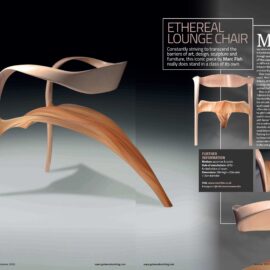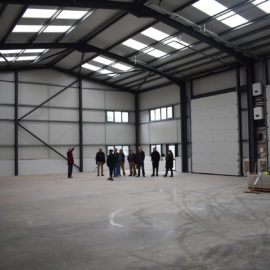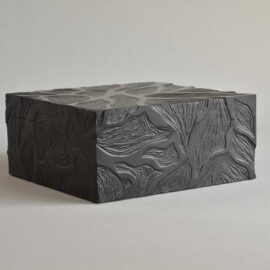You started out as a student here, what made you want to take the course?
I did a design degree ages ago, and decided when I finished that degree that maybe it wasn’t quite what I wanted to get into, it was really competitive. So I ended up taking a very different path and started working in research, in agencies in London for quite a few years, but lacked a sense of creativity through that. So in the end when I thought ‘I’m not doing that for another 30 years’ I wanted to find a way of reintroducing some kind of creativity into my life, and furniture making was one of the possibilities. I knew I wanted to get into not only design stuff but also hands-on work. So I wanted to find a way of making things that might give me a way of making a living.
I was looking for ways of getting into that and I thought I might be able to wing it and take a side door into the industry, but the more people I spoke to the less that seemed like a possibility, so a course seemed the way to go. I visited a few different schools and this was the one that seemed the most creative, the more experimental, the most open to a range of materials. That really appealed to me because I didn’t want it to be a completely carpentry-type approach to furniture design, I wanted it to be a bit more forward looking than that. And that’s certainly what this place offers, I think Marc’s work shows that and the work of the students shows that.
What did you think of the course you took?
I signed up for 12 weeks and I thought I wouldn’t get enough done in that time, so I pushed it to 20 weeks, and then halfway through that course I thought, I’m not going to get enough done in 20 weeks, so I went for the full year. If someone had told me in advance of the course that I would do a bunch of skills-based exercises and then 3 projects I would have said that doesn’t sound like much. I came into this thinking that everything would be much quicker, and in reality fitting those three projects into the year was quite a challenge.
The creativity element was really good, and I like the fact that there was a real emphasis on learning skills first. I can imagine in some places maybe that’s sort of skipped over and people are expected to learn those skills while working on their projects, but I think that’s a recipe for a disastrous project, if you’re learning while you’re making the things that matter. All the practice is not necessarily fun, but then when you’re in the middle of a project and you realise the most accurate way of doing something is to pick up a chisel and do it by hand, you appreciate that all the work you did before has brought you to that point, because you wouldn’t be able to do it otherwise.
Can you tell us a bit about the piece that won you a Guild Mark?
I didn’t necessarily set out to make it, the design evolved. I was playing around with some sculptural forms in my sketchbook and arrived at an idea that I thought would fly, involving quite curvy sculptural legs. It was a bit more arts and craftsy to start off with, but I warped it to become something a bit more unusual. There were also a couple of techniques I wanted to play around with which also slightly drove the design. Here, Marc does a lot of work with veneers and lamination and after doing some test pieces I came up with the idea of using that process for the cross piece that holds the four legs together. I wanted to do some wood shaping and play around with classic joins in a more unusual way. I came across this veneer which I’d not seen before which had a really gnarly pattern to it and I thought that would be nice to feed that into the design along with something quite plain like the sycamore legs.
So it was a real fusion of lots of different things and it came together quite nicely. Although it turns out that, speaking to people about it since and the guys who came to judge it for the Guild Mark, both of them said that I did every aspect of it the most difficult way I could have done it! Which, with hindsight, was maybe a little bit foolish because it could have gone wrong quite easily. But actually, because it didn’t go wrong, or anything that did go wrong could be fixed along the way, it meant that not only did it end up being reasonably impressive but it also meant that I learnt quite a lot through trying to do things in those difficult ways.
So how did you start working with Marc and what does that involve?
There wasn’t much of a gap. I’d finished my year, I’d said to Marc that I was interested in staying on and renting a bench to try and get some of my own work up and running. Shortly after my year finished we were talking about my assessment for the course and Marc just asked if I was interesting in helping him out for a bit. So it happened quite naturally.
I’m only about three weeks into it now so I haven’t worked on lots of different things yet. There’s been a lot of sanding so far! But that’s not all it’s going to be. There’s a few things in the pipeline which are quite interesting. Mostly I’ve been working on a set of mirrors, and a few other bits and pieces.
Is there a technique or style that you’re particularly interested in?
I wouldn’t say I have a style or anything like that that I’m aiming for yet. Some people have said to me that they see some sort of a style connection in the pieces I’ve made so far, but I don’t really see it and it wasn’t intentional. One thing that’s made me feel quite proud when I’ve shown my work to people is that they see it and they say ‘oh it reminds me of…’ or ‘it makes me think of…’ or ‘it feels like…’ and those aren’t necessarily things I’ve thought of myself. But just the fact that you’re triggering those associations for people, that they’re seeing it and it’s sparking something in them, that I find quite satisfying and it’s the kind of thing I’ll try to invoke in future designs.
Do you have any advice for a new student starting at robinson house studio?
I think there are lots of things that occurred to me through my year. I’d recommend to students to really make the most of their time here, because the time does disappear really quickly. Even the year course, which sounds really long, goes so quickly. So don’t cut your days short, don’t take loads of breaks, because you’ll regret it if you get to the end and find you haven’t been able to put the effort in.
Another thing, and it’s a bit like your mum telling you to tidy your room, but keep things in order. Put your tools away, tidy up, because it’s really easy, if you’re working in a really messy environment, for things to get lost or broken or damaged. It’s hard to produce very high quality work if you’re surrounded by tools you’re not using and you can’t find what you need when you need it. Little things like that. But also, be as open minded as possible to ideas and bounce ideas off other people. It was quite good here to have a mix of people, not just the tutors but the students as well, they all generally come from quite different backgrounds in terms of age and experience. Ask them what they think.



